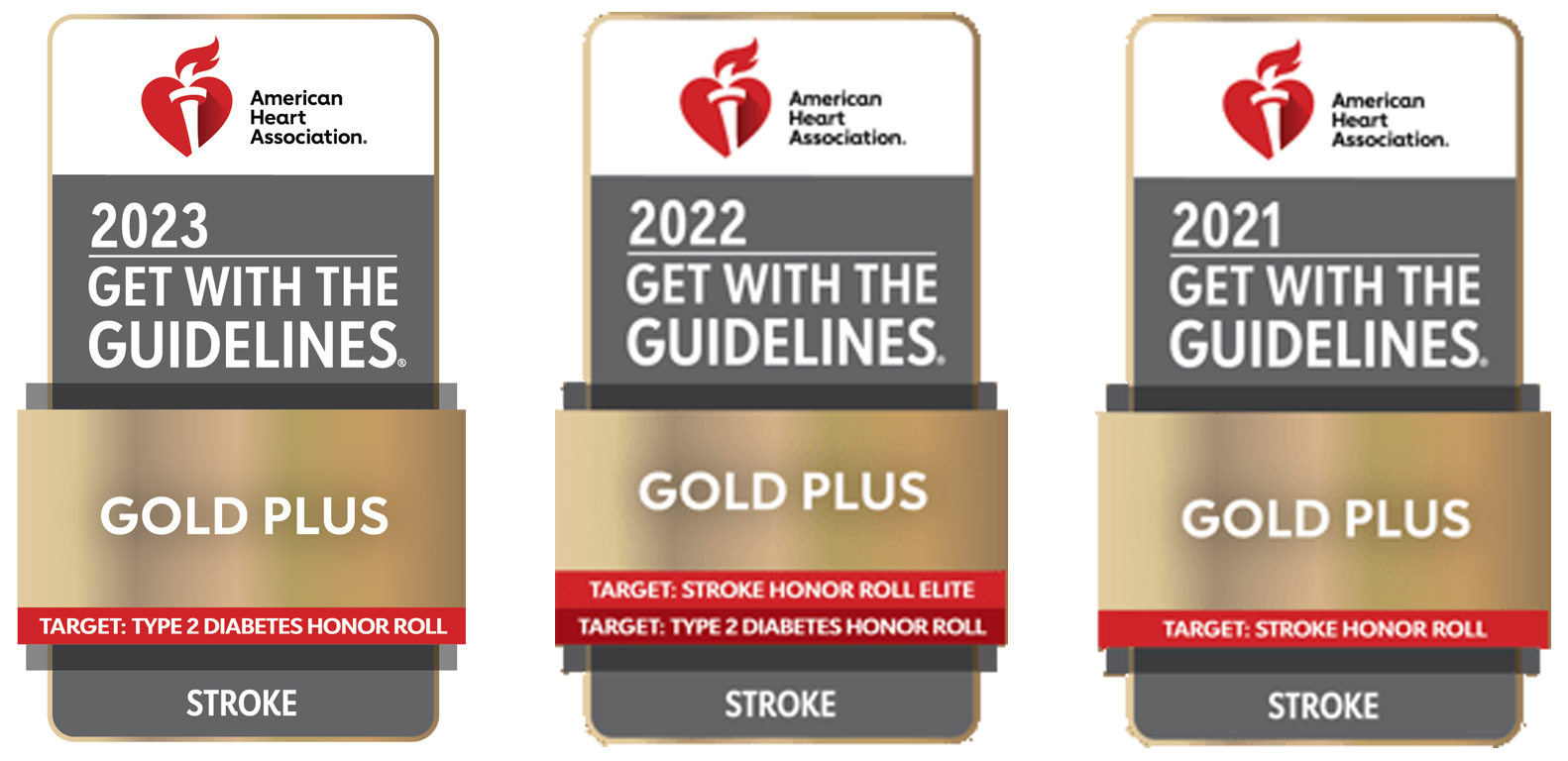Stroke Center
You’re never ready for a stroke. But we are.
In the United States, 795,000 people have a stroke every year, with someone having a stroke every 40 minutes. Stroke is also the leading cause of long-term disability in the United States. One in four strokes happen to those who have had a previous stroke.
If you think you are having a stroke, call 911 immediately! Symptoms of a stroke include:
- Sudden numbness or weakness in the face, arm, or leg, especially on one side of the body.
- Sudden confusion, trouble speaking, or difficulty understanding speech.
- Sudden trouble seeing in one or both eyes.
- Sudden trouble walking, dizziness, loss of balance, or lack of coordination.
As a member of Prime Healthcare New Jersey, Saint Clare’s Health is part of a network of hospitals including Saint Michael’s Medical Center and St. Mary’s General Hospital offering specialized services for stroke treatments.
Time is Brain
With a stroke, every second counts. Minutes could mean the difference between recovery and permanent disability – even death – for stroke victims. Prime Healthcare New Jersey’s hospitals provide patients with exceptional care by a multi-disciplinary team of award-winning vascular neurologists, known as stroke doctors, using the latest technology for the fastest diagnoses and treatment of strokes — all to increase the chances of recovery.
What happens when you have a stroke?
A stroke is a “brain attack” and occurs when a blood vessel that carries blood, oxygen and nutrients to the brain is either blocked by a clot (ischemic stroke) or ruptures (hemorrhagic stroke). Because the blood, oxygen, and nutrients cannot get to the brain, brain cells die.
Speed and Expertise: Diagnostics
- As soon as an ambulance team arrives, care begins. Paramedics conduct a special stroke assessment and call in the results to the Emergency Department while they speed to the hospital.
- Our emergency medicine doctors and nurses are waiting at the emergency room, ready to bring the patient for a brain scan and/or other imaging. Other tests are also performed.
- Then vascular neurologists take the lead. As the patient undergoes the stroke CT diagnostic test, advanced technology allows the neurologist to simultaneously see exactly what is happening inside the patient’s brain so not a second is lost.
- Once the specific diagnosis is made, the stroke team develops a plan for removing the blood clot as quickly as possible.
Speed and Expertise: Treatment
Emergency treatment for stroke depends on whether you’re having an ischemic stroke or a stroke that involves bleeding into the brain (hemorrhagic).
Ischemic stroke
To treat an ischemic stroke, doctors must quickly restore blood flow to your brain. This may be done with:
- Emergency IV medication. Therapy with drugs that can break up a clot has to be given within 4.5 hours from when symptoms first started if given intravenously. The sooner these drugs are given, the better. Quick treatment not only improves your chances of survival but also may reduce complications. An injection of tPA is usually given; this drug restores blood flow by dissolving the blood clot causing your stroke.
- Emergency endovascular procedures. Doctors sometimes treat ischemic strokes directly inside the blocked blood vessel. Endovascular therapy has been shown to significantly improve outcomes and reduce long-term disability after ischemic stroke. These procedures must be performed as soon as possible:
- Endovascular thrombectomy is intended to improve tissue rescue and diminish reperfusion hemorrhage while broadening the population eligible for therapy. This procedure may be performed alone or in conjunction with IV or IA t-PA.
- Medications delivered directly to the brain. Doctors insert a long, thin tube (catheter) through an artery in your groin and thread it to your brain to deliver tPA directly where the stroke is happening. The time window for this treatment is somewhat longer than for injected tPA, but is still limited.
- Removing the clot with a stent retriever. Doctors can use a device attached to a catheter to directly remove the clot from the blocked blood vessel in your brain. This procedure is particularly beneficial for people with large clots that can’t be completely dissolved with tPA. This procedure is often performed in combination with injected tPA.
Hemorrhagic Stroke
Emergency treatment of hemorrhagic stroke focuses on controlling the bleeding and reducing pressure in your brain caused by the excess fluid. Treatment options include:
- Emergency measures. If you take blood-thinning medications to prevent blood clots, you may be given drugs or transfusions of blood products to counteract the blood thinners’ effects. You may also be given drugs to lower the pressure in your brain (intracranial pressure), lower your blood pressure, prevent spasms of your blood vessels and prevent seizures.
- Surgery. If the area of bleeding is large, your doctor may perform surgery to remove the blood and relieve pressure on your brain. Surgery may also be used to repair blood vessel problems associated with hemorrhagic strokes. Your doctor may recommend one of these procedures after a stroke or if an aneurysm, arteriovenous malformation (AVM) or other type of blood vessel problem caused your hemorrhagic stroke:
- Surgical clipping. A surgeon places a tiny clamp at the base of the aneurysm, to stop blood flow to it. This clamp can keep the aneurysm from bursting, or it can keep an aneurysm that has recently hemorrhaged from bleeding again.
- Coiling (endovascular embolization). Using a catheter inserted into an artery in your groin and guided to your brain, your surgeon will place tiny detachable coils into the aneurysm to fill it. This blocks blood flow into the aneurysm and causes blood to clot.
- Surgical AVM removal. Surgeons may remove a smaller AVM if it’s located in an accessible area of your brain. This eliminates the risk of rupture and lowers the risk of hemorrhagic stroke. However, it’s not always possible to remove an AVM if it’s located deep within the brain, it’s large, or its removal would cause too much of an impact on brain function.
- Stereotactic radiosurgery. Using multiple beams of highly focused radiation, stereotactic radiosurgery is an advanced minimally invasive treatment used to repair blood vessel malformations.
Stroke Recovery and Rehabilitation
For stroke patients, inpatient beds have been dedicated at Saint Clare’s Denville and Dover hospitals, and has specially trained nurses are available to provide this unique, focused care. The Centers also offer community education programs focusing on the prevention, diagnosis and treatment of strokes.
Saint Clare’s Denville Hospital will host a monthly stroke support group. The group meets the first Thursday of every month in the Saint Clare’s Denville Hospital Auditorium. For more information, call 973-625-6479.
Every person’s stroke recovery is different. Services include:
- Doctor trained in brain conditions (neurologist)
- Rehabilitation doctor (physiatrist)
- Rehabilitation nurse
- Dietitian
- Physical therapist
- Occupational therapist
- Recreational therapist
- Speech pathologist
- Social worker or case manager
- Psychologist or psychiatrist
- Chaplain
Stroke Detection and Prevention
Featured Services

Stroke Center
Maternity

Bariatric Surgery
Surgical Services



